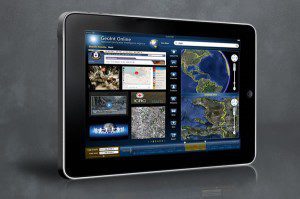
Raytheon is using internal research and development money to develop its GOtab geospatial intelligence tablet.
Today an awful lot of effort by analysts goes into discovering and retrieving information that they then analyze to solve intelligence problems, said Kevin Brown, technical director for geospatial intelligence programs at Raytheon Intelligence and Information Systems in Garland, Texas. We are trying to make information easier to discover and retrieve.
With that goal in mind, Raytheon is developing the Geoint On-line Tablet, or GOtab, an online application that gives users a variety of ways to find and retrieve geospatial data. GOtab is an emerging capability that can be adjusted and tailored to perform different jobs, Brown said. It's not a shrink-wrapped product on a pallet.
GOtab, which can be used on desktop computers, laptops or mobile devices, offers an intuitive visual display that soldiers, intelligence analysts and first responders can use to search for geospatial data. A GOtab user, for example, can use a touch screen to request geospatial data on a specific geographic area. Users also can type in a query, using words to describe the type of information they seek. Or they can use GOtab to retrieve geospatial data for specific dates or time periods. We are trying to make it as intuitive as possible so you don't have to be a skilled analyst to discover information and find the geospatial intelligence you need, Brown said.
In addition, GOtab offers users a chance to share information. It's a collaboration tool, Brown said. First responders can provide updated information that can be shared with their colleagues at an operations center and vice versa, he added.
Raytheon is using internal research and development money to develop GOtab. According to Brown, strong interest in the product from government agencies could lead to external funding within a year. Currently, GOtab provides unclassified geospatial data, but company engineers are designing the online application to handle classified and unclassified information.
General Dynamics Advanced Information Systems also is devoting funding to an effort to improve customer access to geospatial data. At the GEOINT Symposium in San Antonio in October, General Dynamics demonstrated Multi-INTCloud-on-Demand, a project designed to provide remote access to a variety of online applications, data and tools. Company officials showed potential customers how a Blackberry device could help them gain access to data and applications residing in the company's own cloud, which is based in Annapolis Junction, Md.
We wanted to show the ability to keep applications in the Washington, D.C., area and let people come in through a dial-up modem, said Jay Mork, senior director for advanced programs at General Dynamics Advanced Information Systems of Fairfax, Va. We also tailored the applications to run in that environment.
By managing data and applications in the cloud, government agencies will be able to reduce the cost of data handling and data storage, according to Mork. Instead of moving hardware, software and the people needed to secure and maintain that technology to various sites around the globe, government agencies could maintain centralized databases and applications. Only the data and imagery would travel.
One of the challenges of getting geospatial intelligence applications to work on mobile devices is the fact that they are so complex and bandwidth intensive. But the state of the technological art continues to advance, helped in part by commercial firms working to improve the quality of video streamed over the Internet. General Dynamics' Multi-INTCloud-on-Demand uses open source software to take advantage of breakthroughs in military and commercial software development.
Both Raytheon's GOtab and General Dynamics' Multi-INTCloud-on-Demand rely on advances in cloud computing to provide geospatial data to customers. Geospatial intelligence is unique because of the enormous size of the data files. In the past, analysts had to search through those data files to respond to a request for specific images or features within those images.
By storing massive amounts of geospatial data in the cloud and using cloud-based applications to conduct searches, intelligence agencies can identify the information they seek more quickly than was previously possible, according to Kevin Jackson, general manager of cloud services for NJVC, a technology services provider based in Vienna, Va. Once identified, geospatial intelligence can be rapidly transmitted to users through their mobile devices.
U.S. defense and intelligence agencies rely on the U.S. National Geospatial-Intelligence Agency (NGA) to provide maps and other types of geospatial data to support national security and disaster relief operations. If the NGA can use cloud computing approaches and cloud computing operational models to provide geospatial intelligence better, faster and more precisely anywhere in the world, that is going to make every intelligence agency much better, Jackson said.
Source: Space News

